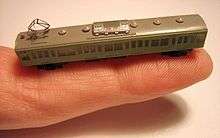T gauge
| T Gauge | |
|---|---|
 | |
| Scale | 0.0267 in to 1 ft / 1:450 |
| Scale ratio |
1:450 (Japanese 3 ft 6 in (1,067 mm) gauge) 1:480 (Standard gauge) |
| Model gauge | 3 mm (0.118 in) |
| Prototype gauge | commercially available models are of 3 ft 6 in (1,067 mm) gauge. |
T Gauge (1:450), is a model railroad scale with a track gauge of 3 mm (0.118 in). It was introduced at the Tokyo Toy Show in 2006 by KK Eishindo of Japan, and went on sale in 2007. It is the smallest commercial model train scale in the world. Since mid-2009, Railway Shop (Hong Kong) is the exclusive licensed manufacturer.
The models are powered with a battery-powered throttle (with optional AC adapter) at a maximum output of 4.5 V DC. To improve power pickup and tractive effort, the powered cars are fitted with magnetic wheels, and the track has steel rails.
The first train released is the Japanese 103 series commuter train in different versions. Each standard trainset comes with two powered cars, which are located in the center of the train. The front and rear cars are equipped with directional headlights. The tiny pantographs are made of etched stainless steel. The Hankyu Railway 9000 EMU Series and the Kiha 40 DMU were added to the line of available trainsets in early 2010, and feature improved mechanisms for better performance.
Track is offered with three different curve radii: 120 millimetres (4.72 in), 132.5 and 145 millimetres (5.22 and 5.71 in); straight tracks are 30 and 60 millimetres (1.181 and 2.362 in) long. As of Q1 2010, switches (or turnouts) and crossovers are in the final stages of production. The sectional track is "roadbed" style, with integrated ballast. The rail is approximately 0.040 inches (1.016 mm) high ("Code 40"). Track pieces are connected with gold-plated metal rail joiners plus plastic clips in the roadbed. Different types of dummy catenary masts can be attached to the track. Flex track is available in one metre lengths, with wood or concrete ties (not "roadbed" style).
The trains are powered by three 1.5 V AA batteries, an optional AC adapter, or a USB plug. The direction of the train is changed by pressing a button. The control system includes two infrared sensors that can be clipped to the track. These sensors are used to automatically change the direction of the train if it is being operated on a linear (or point-to-point) track configuration, as opposed to a continuous loop. The throttle allows for either instant reversing, or reversing after a delay of approximately 5 seconds. The basic track set includes an oval of track, controller, electrical feeder, two sensors, rerailer, and a wheel cleaning device for the powered trains. The AC adapter is available separately; plug versions for continental Europe, Britain and USA are available.
In addition to the trains and track, available accessories include a large variety of scenic items: houses and apartment buildings, figures and animals, trees, bikes, boats and more. The houses are assembled and pre-painted, with fully detailed interiors that the modeler can install. The plastic figures, etched metal bikes, and other small items have small pins to make installation on a layout easier; the modeler simply makes a hole and inserts the detail into the hole using a toolkit available from Eishindo. Road signs, traffic lights and other street furniture is available, as well as a street decoration decal sheet, which comes with a scale ruler to aid the placement of markings and details.
One unusual side-effect of the magnetic wheels of the powered units is that they can climb acute grades (as steep as 45 degrees).
Additionally, Eishindo sells a train set for use in G Scale model railroading. The set includes an oval of track, a special riding-style locomotive and cars, and G scale figures to ride the train.
T scale trains may be used with model airplanes and model airports in the 1:400/1:500 scale range. Eishindo has been planning to produce a modest line of airplanes and accessories of their own.
See also
References
External links
| Wikimedia Commons has media related to T scale. |
- (Japanese) kk-eishindo.co.jp, corporate website.
- www.tgauge.com, largest online vendor serving customers internationally.
- trainaidsa.com, a USA vendor that services International users.
- (German) uwefenk.de, German Railroad Models in T Gauge
- TalkingTGauge.net, a discussion forum for T Gauge modelling, techniques and layouts
